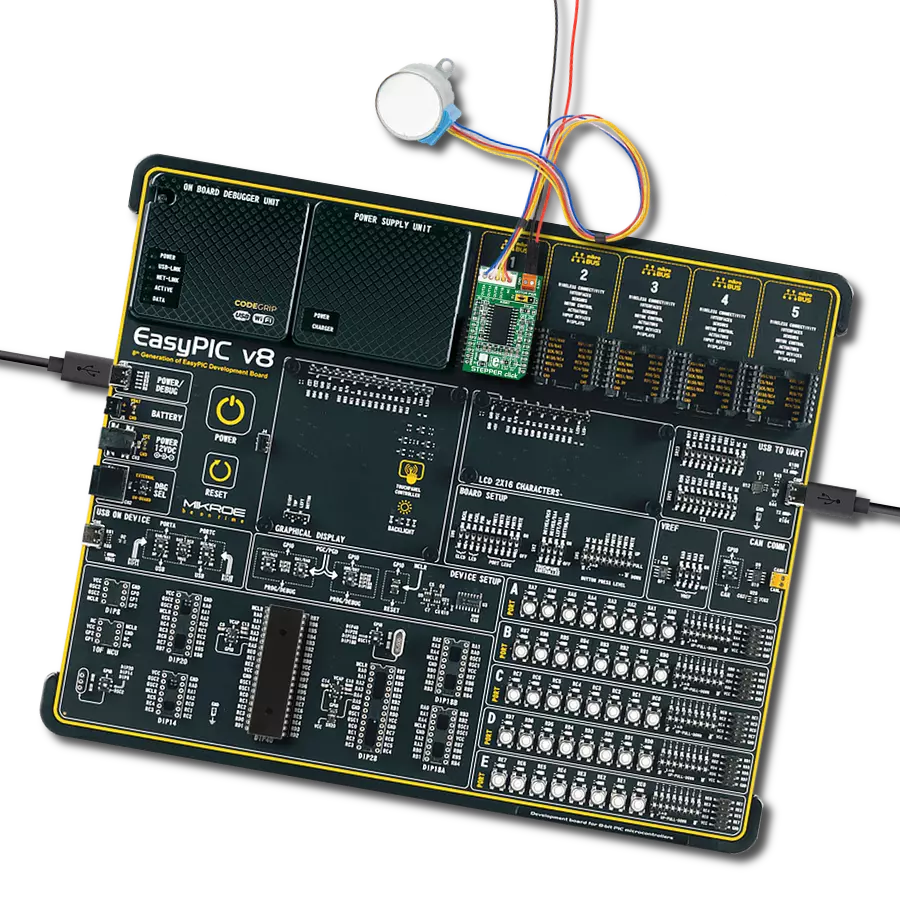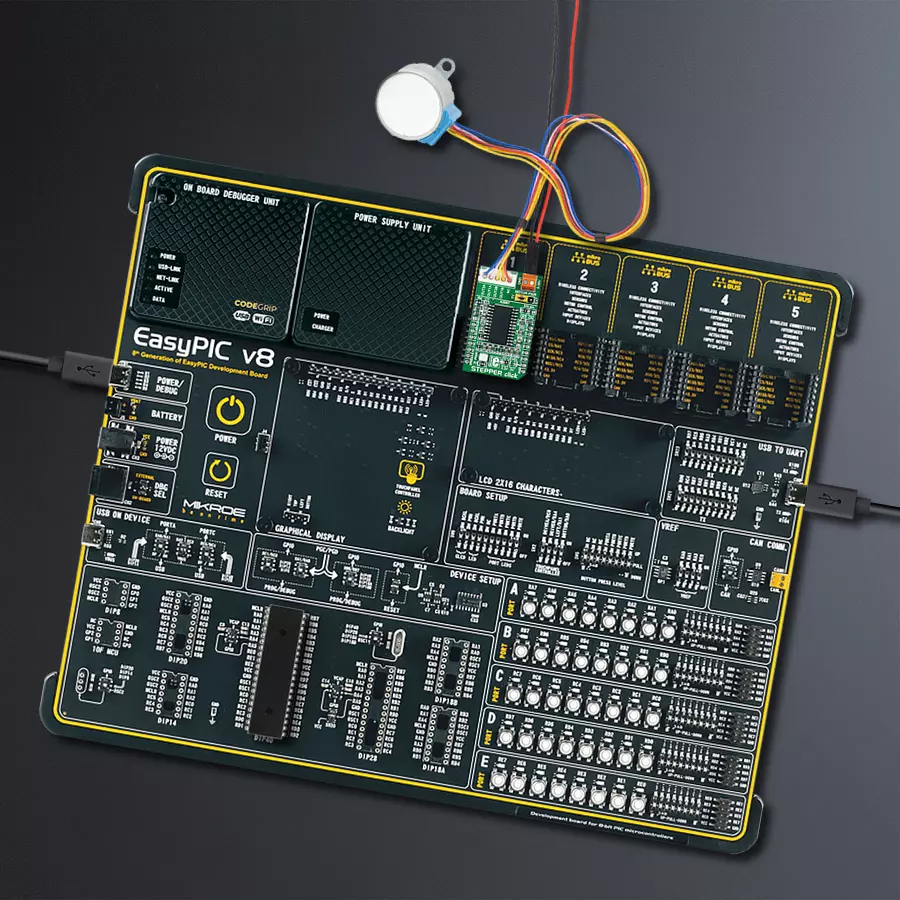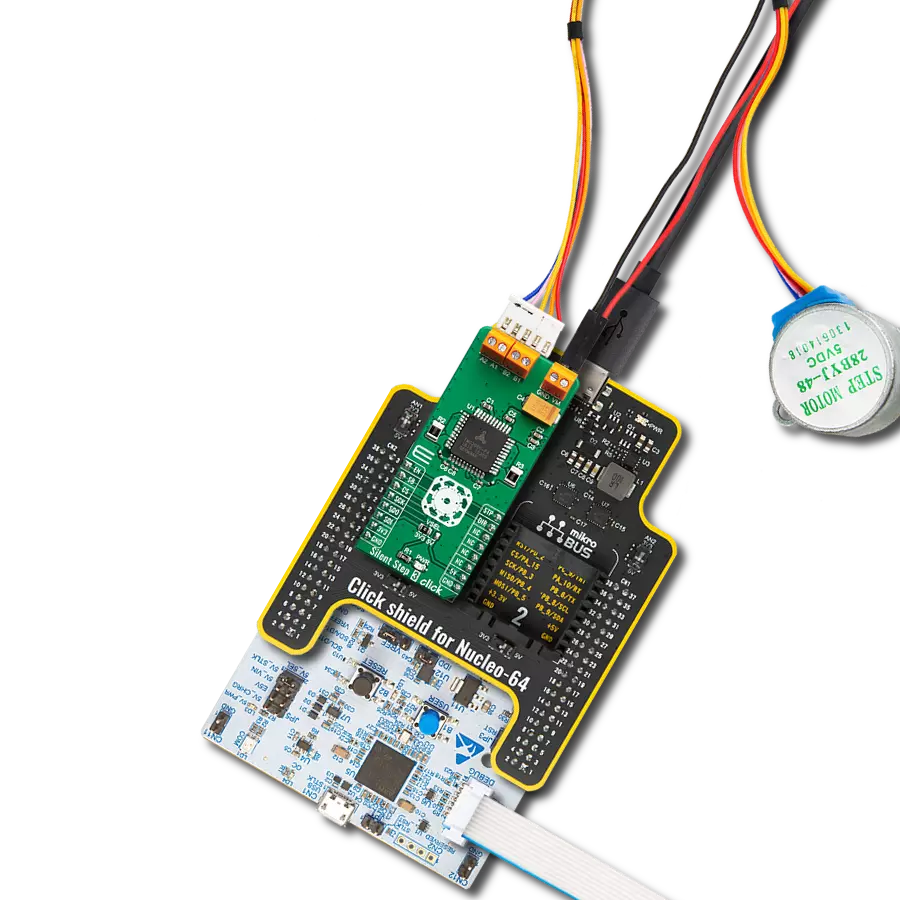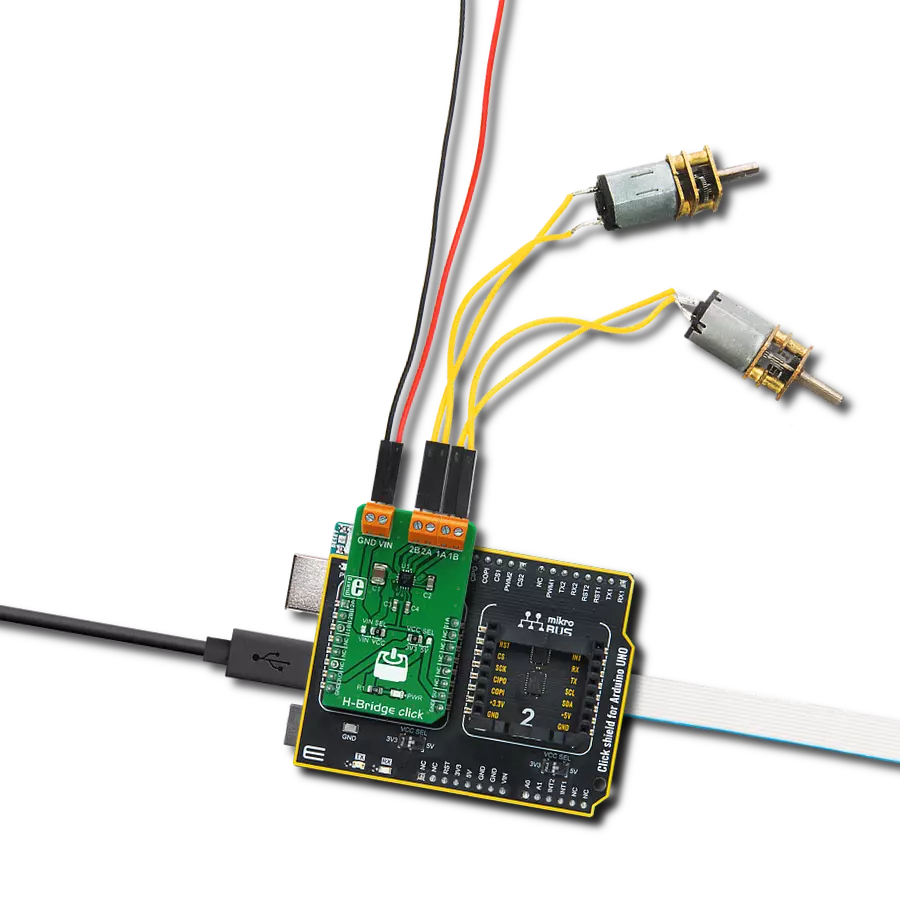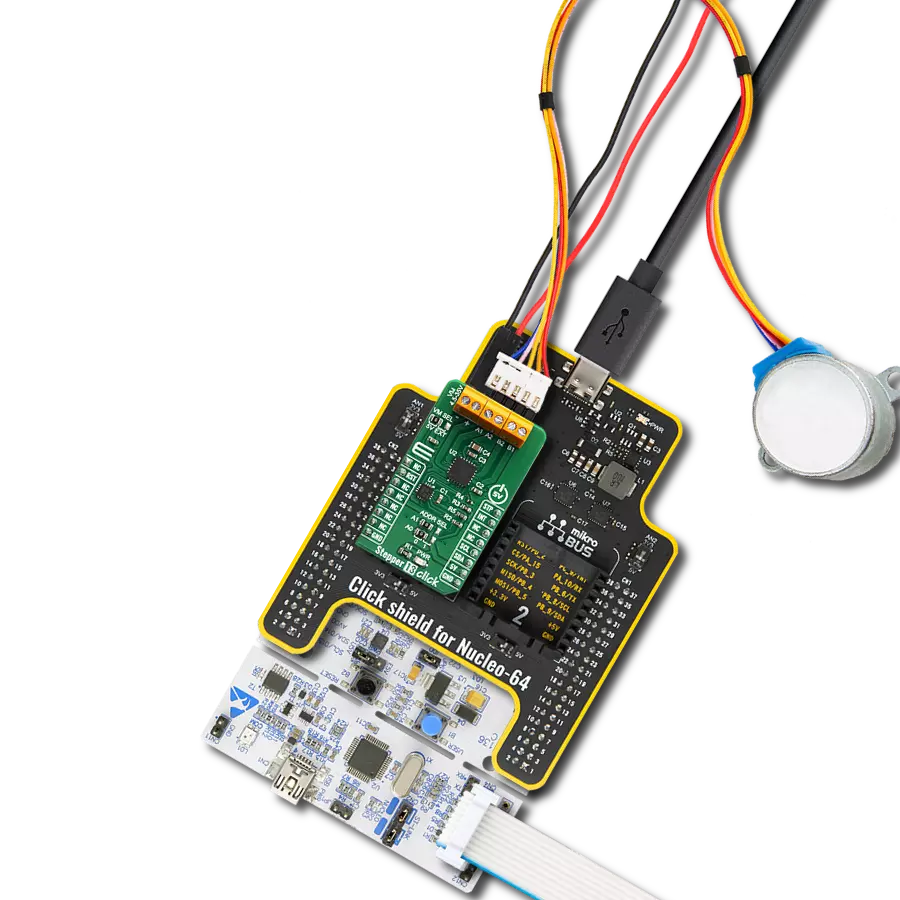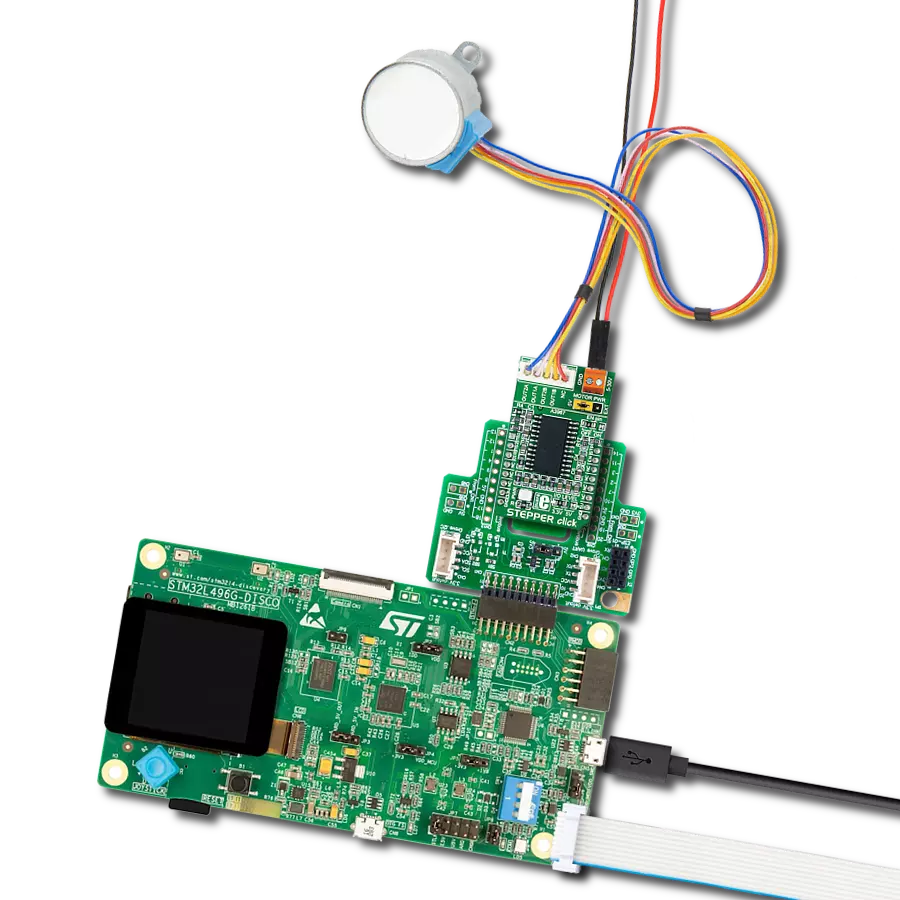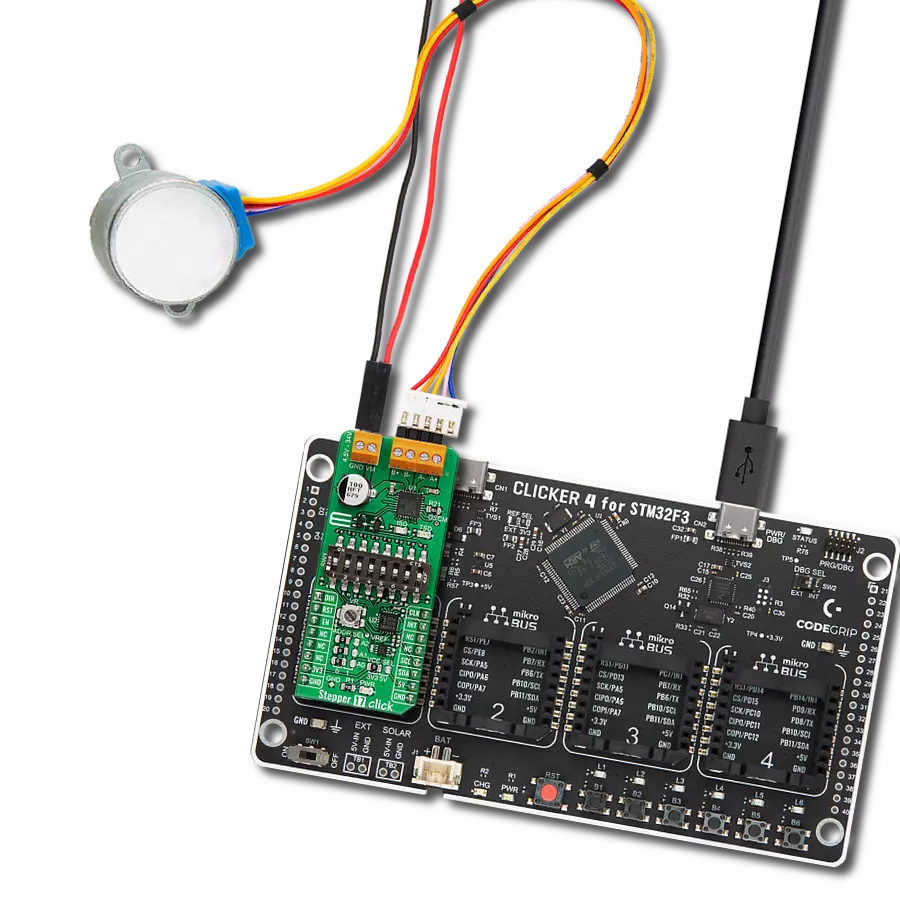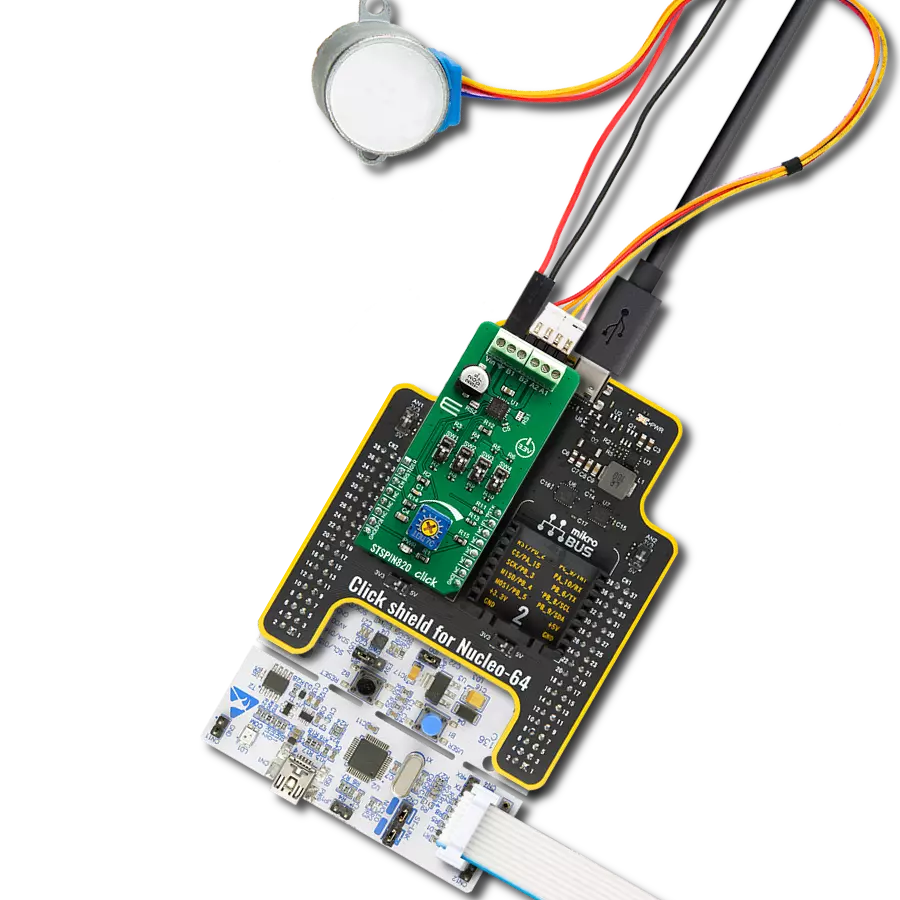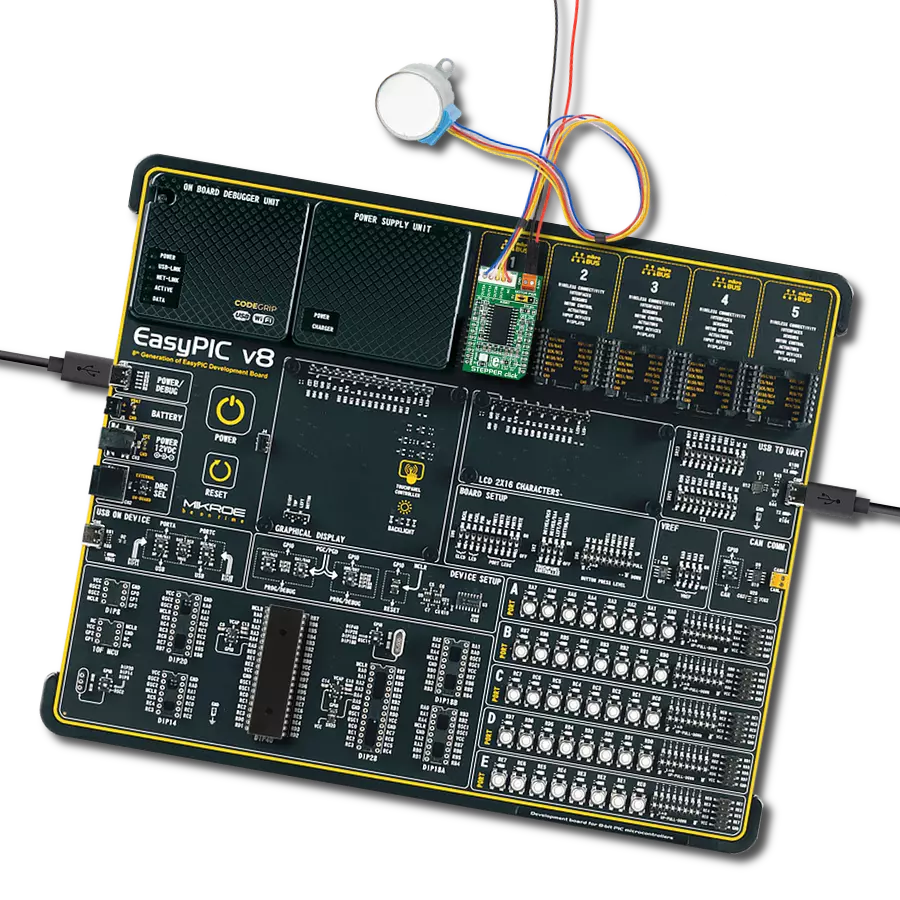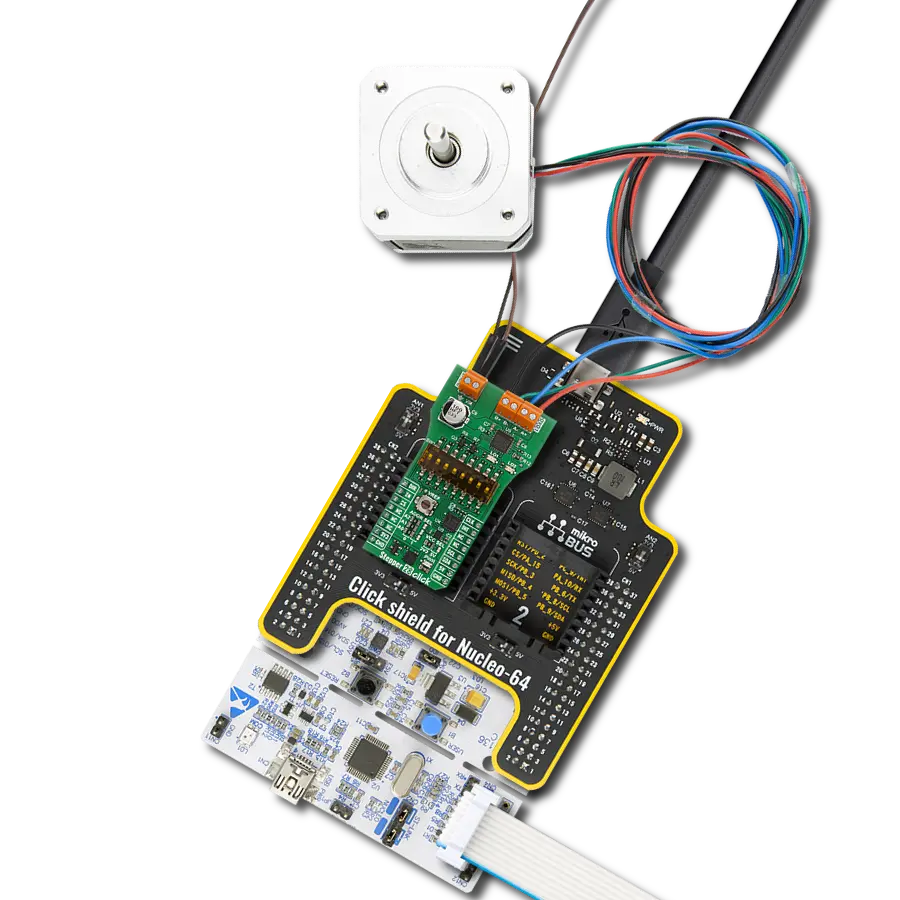Control the bipolar stepper motor's movement in both directions using simple step control inputs from your host MCU
A
A
Hardware Overview
How does it work?
Stepper Click is based on the A3967, a micro-stepping driver with a translator from Allegro Microsystems. This highly integrated IC offers a simple bipolar stepper motor control interface, thanks to the integrated translator section. This section controls the output drivers, providing smooth action of the stepper motor. By controlling the current intensity throughout the rotation cycle, a constant torque is achieved for every position. The current regulator uses an internal comparator, DA converter, and external sensing resistor. The sensing resistor value determines the maximum current during the operation, limiting it to 568mA when using 5V or 350mA when using 3.3V as the reference voltage. Additional features of the Stepper Click include under-voltage, shoot-through, and thermal protection so the Click board™ can operate reliably. Its input voltage range of up to 25V can drive a wide range of stepper motors with
up to 750mA max. The Click board™ offers a choice to use a power source for driving the motor: one is the external voltage routed to the input connector, while the other is a 5V power rail from the mikroBUS™. While using the external connector, the voltage of the external power supply should remain below 25V. Selection between the external power supply and 5V rail from the mikroBUS™ can be made by moving the jumper labeled as MOTOR PWR to either the 5V position or EXT position. The stepper motor can be connected via the disconnectable crimp style XH connector with 2.5mm pitch, usually found on many small-size stepper motors. This header is optional and comes unsoldered in case some other type of header or connector needs to be used instead. Stepper Click uses GPIO pins to communicate with the host MCU. A LOW to HIGH transition on the STP pin will perform one rotational step. The logic
state on the DIR pin controls the direction of the rotation. The step size is determined by two pins: MS1 and MS2. It is possible to work with full steps (using two phases), half, quarter, and eighth steps. The SMD jumper labeled as the EN pin can be used to route the #EN pin of the IC to the EN pin of the mikroBUS™. This allows the host MCU to turn the A3967 ON or OFF. By default, this jumper is positioned to route the #EN pin to the GND directly, permanently enabling the IC. This Click board™ can operate with either 3.3V or 5V logic voltage levels selected via the I/O LEVEL jumper. This way, both 3.3V and 5V capable MCUs can use the communication lines properly. Also, this Click board™ comes equipped with a library containing easy-to-use functions and an example code that can be used as a reference for further development.
Features overview
Development board
EasyPIC v8 is a development board specially designed for the needs of rapid development of embedded applications. It supports many high pin count 8-bit PIC microcontrollers from Microchip, regardless of their number of pins, and a broad set of unique functions, such as the first-ever embedded debugger/programmer. The development board is well organized and designed so that the end-user has all the necessary elements, such as switches, buttons, indicators, connectors, and others, in one place. Thanks to innovative manufacturing technology, EasyPIC v8 provides a fluid and immersive working experience, allowing access anywhere and under any
circumstances at any time. Each part of the EasyPIC v8 development board contains the components necessary for the most efficient operation of the same board. In addition to the advanced integrated CODEGRIP programmer/debugger module, which offers many valuable programming/debugging options and seamless integration with the Mikroe software environment, the board also includes a clean and regulated power supply module for the development board. It can use a wide range of external power sources, including a battery, an external 12V power supply, and a power source via the USB Type-C (USB-C) connector.
Communication options such as USB-UART, USB DEVICE, and CAN are also included, including the well-established mikroBUS™ standard, two display options (graphical and character-based LCD), and several different DIP sockets. These sockets cover a wide range of 8-bit PIC MCUs, from the smallest PIC MCU devices with only eight up to forty pins. EasyPIC v8 is an integral part of the Mikroe ecosystem for rapid development. Natively supported by Mikroe software tools, it covers many aspects of prototyping and development thanks to a considerable number of different Click boards™ (over a thousand boards), the number of which is growing every day.
Microcontroller Overview
MCU Card / MCU
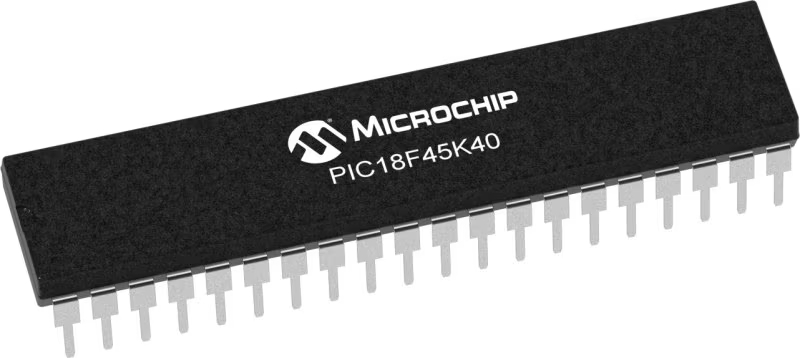
Architecture
PIC
MCU Memory (KB)
32
Silicon Vendor
Microchip
Pin count
40
RAM (Bytes)
2048
You complete me!
Accessories
The 28BYJ-48 is an adaptable 5VDC stepper motor with a compact design, ideal for various applications. It features four phases, a speed variation ratio of 1/64, and a stride angle of 5.625°/64 steps, allowing precise control. The motor operates at a frequency of 100Hz and has a DC resistance of 50Ω ±7% at 25°C. It boasts an idle in-traction frequency greater than 600Hz and an idle out-traction frequency exceeding 1000Hz, ensuring reliability in different scenarios. With a self-positioning torque and in-traction torque both exceeding 34.3mN.m at 120Hz, the 28BYJ-48 offers robust performance. Its friction torque ranges from 600 to 1200 gf.cm, while the pull-in torque is 300 gf.cm. This motor makes a reliable and efficient choice for your stepper motor needs.
Used MCU Pins
mikroBUS™ mapper
Take a closer look
Click board™ Schematic

Step by step
Project assembly
Software Support
Library Description
This library contains API for STEPPER Click driver.
Key functions:
stepper_set_step_mode- This function sets the step mode resolution settingsstepper_set_direction- This function sets the motor direction by setting the DIR pin logic statestepper_drive_motor- This function drives the motor for the specific number of steps at the selected speed
Open Source
Code example
The complete application code and a ready-to-use project are available through the NECTO Studio Package Manager for direct installation in the NECTO Studio. The application code can also be found on the MIKROE GitHub account.
/*!
* @file main.c
* @brief Stepper Click Example.
*
* # Description
* This example demonstrates the use of the Stepper Click board by driving the
* motor in both directions for a desired number of steps.
*
* The demo application is composed of two sections :
*
* ## Application Init
* Initializes the driver and performs the Click default configuration.
*
* ## Application Task
* Drives the motor clockwise for 64 full steps and then counter-clockiwse for 128 half
* steps with 2 seconds delay before changing the direction. All data is being logged on
* the USB UART where you can track the program flow.
*
* @note
* Step Motor 5v [MIKROE-1530] is a fully compatible stepper motor for this Click board:
* https://www.mikroe.com/step-motor-5v
*
* @author Stefan Filipovic
*
*/
#include "board.h"
#include "log.h"
#include "stepper.h"
static stepper_t stepper; /**< Stepper Click driver object. */
static log_t logger; /**< Logger object. */
void application_init ( void )
{
log_cfg_t log_cfg; /**< Logger config object. */
stepper_cfg_t stepper_cfg; /**< Click config object. */
/**
* Logger initialization.
* Default baud rate: 115200
* Default log level: LOG_LEVEL_DEBUG
* @note If USB_UART_RX and USB_UART_TX
* are defined as HAL_PIN_NC, you will
* need to define them manually for log to work.
* See @b LOG_MAP_USB_UART macro definition for detailed explanation.
*/
LOG_MAP_USB_UART( log_cfg );
log_init( &logger, &log_cfg );
log_info( &logger, " Application Init " );
// Click initialization.
stepper_cfg_setup( &stepper_cfg );
STEPPER_MAP_MIKROBUS( stepper_cfg, MIKROBUS_1 );
if ( DIGITAL_OUT_UNSUPPORTED_PIN == stepper_init( &stepper, &stepper_cfg ) )
{
log_error( &logger, " Communication init." );
for ( ; ; );
}
stepper_default_cfg ( &stepper );
log_info( &logger, " Application Task " );
}
void application_task ( void )
{
log_printf ( &logger, " Move 64 full steps clockwise \r\n\n" );
stepper_set_step_mode ( &stepper, STEPPER_MODE_FULL_STEP );
stepper_set_direction ( &stepper, STEPPER_DIR_CW );
stepper_drive_motor ( &stepper, 64, STEPPER_SPEED_FAST );
Delay_ms ( 1000 );
Delay_ms ( 1000 );
log_printf ( &logger, " Move 128 half steps counter-clockwise \r\n\n" );
stepper_set_step_mode ( &stepper, STEPPER_MODE_HALF_STEP );
stepper_set_direction ( &stepper, STEPPER_DIR_CCW );
stepper_drive_motor ( &stepper, 128, STEPPER_SPEED_VERY_FAST );
Delay_ms ( 1000 );
Delay_ms ( 1000 );
}
int main ( void )
{
/* Do not remove this line or clock might not be set correctly. */
#ifdef PREINIT_SUPPORTED
preinit();
#endif
application_init( );
for ( ; ; )
{
application_task( );
}
return 0;
}
// ------------------------------------------------------------------------ END
